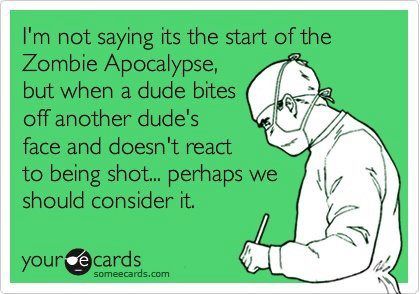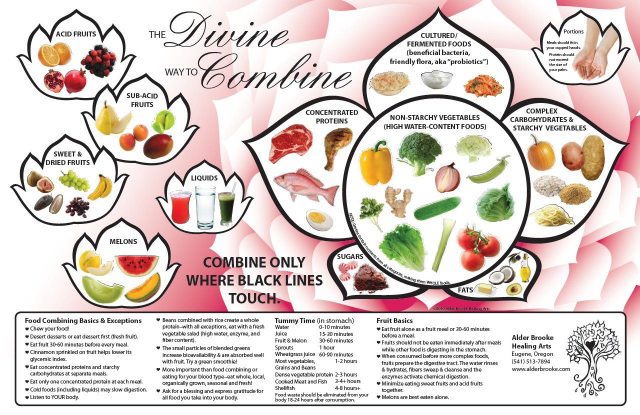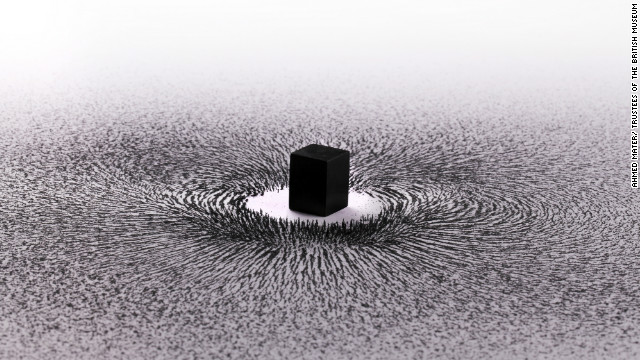Do you believe in zombies?
The prestigious Archaeology Magazine has posted research detailing evidence of a zombie outbreak in ancient Egypt near Hierakonpolis approximately 5000 years ago.
Yes, Archaeology Magazine!
The intrepid archaeologists posited that these zombie attacks were caused by a viral culprit:

The idea that zombies are supernatural beings needs to be discarded. They are not the Spawn of Hell, although, they certainly look the part. They are, or were, people who were infected by the Solanum virus. The virus creates a zombie by eating away the frontal lobe of the brain for replication, thus destroying it. The virus mutates the brain and allows the brain to remain alive but dormant and without the need for oxygen. Once the mutation is complete, approximately 23 hours from infection to fully functioning zombie, the ghoul will be on the unending search for living human flesh, thus spreading the infection.
If you don’t believe, have you at least noticed that zombies are the new black? They’re everywhere, and they have a plethora of fans. On TV there is Bite Me, Ugly American and Team Daryl which was spawned by The Walking Dead (chosen as the #1 Show on Television).
A Google search of ‘zombies’ yields 117 million hits.
There are actually three different kinds of zombies. All of them are like humans in some ways, and all of them are lacking something crucial (something different in each case).
Hollywood zombies. These are found in zombie B-movies. Their defining feature is that they are dead, but “reanimated”. They are typically rather mean, and fond of human flesh. The zombies pictured on this page are mostly Hollywood zombies (though I’m informed that the one at the bottom is really a ghost demon). An expert tells me that the name should be “Pittsburgh zombies”, since the most important zombie movies were made in Pittsburgh, but somehow it doesn’t have the same ring.
Haitian zombies. These are found in the voodoo (or vodou) tradition in Haiti. Their defining feature seems to be that they lack free will, and perhaps lack a soul. Haitian zombies were once normal people, but underwent zombification by a “bokor” through spell or potion, and are afterwards used as slaves.
Philosophical zombies. These are found in philosophical articles on consciousness. Their defining features is that they lack conscious experience, but are behaviorally (and often physically) identical to normal humans.
Both the fear of contagion and the fear of predation are hard-wired into the human central nervous system. In other words, these are the cross-cultural,‘instinctive,’ pre-cognitive and pre-linguistic buttons that the modern zombie pushes.
The word zombie, the living dead, has its roots in West African/Haitian vodou religion. Historians and anthropologists trace the origin of zombies to the folklore of several tribes in western Africa, from Ghana to Nigeria. During the slave trade of the late 1500s through the 1800s, persons from these regions were spirited away from their homes to till the plantations of the Caribbean and the European colonies, bringing with them the voodoo culture of magic and spells.
The zombie as represented in film symbolizes a mindless, soulless being with the desire to consume the living, as opposed to the vodou zombie who exists to do the bidding of its master at all costs. At its most basic definition, the term zombie refers to a person who is no longer thinking for themselves. In the case of the West African/Haitian culture, this person is a slave.
Like humans, zombies came out of Africa. There they led rich lives being worshipped as Congolese snake gods (nzambi). The ability of certain snakes to use poison to paralyze their prey was ritualistically imitated by tribal priests, who then proclaimed themselves able to resurrect the dead as well. In such vodoun or Obeah cults, the term nzambi migrated in meaning to “spirits of the dead.”
Transported to the Americas, vodoun took root in Caribbean slave culture, mating with indigenous religions to spawn zombies, zumbies, jumbies, and duppies and spreading northward to the continent. By the 17th century vodoun was strong enough to trigger the Salem witch hysteria of 1692. Tituba, a Carib Indian slave bought by Samuel Parris in Barbados and brought to Salem, filled her young mistresses’ heads with vodoun notions like invocation of the devil, possession, trances, animal familiars, and the sticking of pins into “poppetts” (dolls) made to resemble enemies. The girls’ psyches broke down, alternating between hysterics and catatonia. Tituba was among the first arrested and was the first to confess, in lurid detail—yet she survived while 24 others did not.
To this day, voodoo is prominent in western Africa, Haiti, New Orleans, and parts of the Caribbean Islands.
Although most cultures would consider the zombie to be a fictional creature, zombiism (i.e., being a zombie) is rather common in Haiti, with instances of people being reported dead by loved ones, only to be spotted fully reanimated and wandering around town several weeks to several years later. In Haitian and African culture, zombification is a punishable offense on the same order of severity as murder.
What is lacking from the historicist or contextualist account of zombies is an accurate understanding of the psychology that underlies the fascination and repulsion that zombies engender. All cultural concepts are engaged in a struggle for survival, but that struggle is not fought in some disembodied ether – it’s fought in people’s minds.
What’s on people’s minds is determined by their experience and their culture, certainly, but also constrained and, in the first place, enabled by genetics. People are disposed to be interested in a limited range of things, to be afraid of a limited number of things.
Although we fear the zombies we see portrayed in film, most may, on some levels, subconsciously relate to the symbol being communicated. We use the term “mindless zombie” in a defaming manner toward those who are perceived as blindly following those not deemed fit to follow. If the leader or organization is not one in which one can pledge loyalty, then they are seen as manipulative and unworthy of anyone’s fealty and those that follow them are regarded as mindless due to their failure to perceive the true nature of the organization others so easily recognize. The zombie as defined here is not one to be feared but is one some may pity or even worse, scorn.
Exploring the zombie as a cultural symbol forces us to confront the mind/body issue that many films fail to address. Where religion struggles with the mind/body issue as a reality, science approaches it as a philosophical exercise whose results focus on concepts that would prove the plausibility of a consciousness in artificial lifeforms which result in an artificial intelligence. The transference of the consciousness from one physical vessel to another is a widely accepted theme in a majority of science fiction television shows and films–from the alien technology used in the Stargate Universe that allows a person to swap bodies millions of light years apart to the transference of the human consciousness into a cybernetic form in the upcoming television series Caprica.
This concept has remained a major topic of religious and philosophical study for much of humanity’s history. Both the concept of a “mindless zombie” and the theory of a dualistic human state–the separation of mind and body– is at the core of Joss Whedon’s television series Dollhouse. The significance of this study raises the question not only of the consciousness remaining viable apart from its original form but also whether the body can exist without the consciousness? If the body is capable of existing without a consciousness, is the vessel or shell still a person? The theoretical plausibility of zombies raise the much deeper issue of personhood and as such makes our understanding of the culture symbolism of zombies even more crucial.
The zombie taps into deep-rooted, ancient fears that extend far back in to our hominid lineage and beyond: notably the fear of contagion and the fear of predation. Humans are equipped with ‘elementary feature detectors geared to respond to biologically relevant threats,’ as Arne Öhman has spent a life of research demonstrating, and we react strongly and predictably to features that seem to represent ancestral dangers, even when the source is only a fleeting shadow in the twilight, flickering images on the silver screen, or indeed mental images procured by ink on paper.
There is a clear pop-culture fascination with zombies. Forget Halloween costumes. They’re dragging themselves along on a hit show, “The Walking Dead,” on AMC, holding conventions, taking part in protests and lurching in “zombie walks” through cities from Toronto to Omaha, Nebraska.
Part of this, I’m sure, is just an expression of our culture’s enjoyment of seeing violence performed on seemingly deserving subjects: Zombies can be killed in a variety of creative ways, and since they don’t feel pain and are already dead, there’s apparently no need to feel guilty about it.
But what if this fascination is about more than just gross-out gore and action thrills?
What if it represents a subtle, subconscious understanding that something is wrong—spiritually wrong—with our culture. Zombies represent the appetite divorced from everything else. They are incapable of judgment, self-awareness, or self-preservation. Though they still move and act, they are not really alive. They hunger and are never filled. And they aren’t just hungry for anything—they specifically want to eat the living, and even more specifically the brain, seat of rationality and self control.
In Pauline terms, they are the sarx in its purest form. Without a soul to control it, the flesh is a slave to its own desires. The rise in popularity of zombies, then, may reflect a rise in anxiety over the elevation of appetite in modern life, a popular recognition that appetite has gotten out of control, and that unchecked, unreflective, and immoderate appetite is a form of death.
It’s this symbolic potential that seems to be behind the recent zombie film resurgence.
Zombies may inspire fear within those who witness them in popular culture, and this fear can be compared with the same emotions that people might experience when they encounter the unknown. Some of the fears brought on by zombies include fear of brain dysfunction, fear of death, and feelings of hopelessness. Zombies, in turn, make these fears into something concrete, something we can reflect upon from a safe distance, as opposed to more active methods of facing our fears, such as high-risk activities like sky diving or bungee jumping.
It’s not always subconscious, actually; Romero’s Dawn of the Dead overtly uses zombies to satirize consumerism. The humans are besieged by the walking dead in a shopping mall, and one of them says that the zombies have gathered there because that’s where they always went in life. Shaun of the Dead uses zombies in the same way, though more humorously. It takes a very long time for Shaun to realize that all of the shambling, vacant-eyed, disgusting people around him have actually become zombies, as their behavior really hasn’t changed all that much. (At the movie’s end, Shaun’s friend Ed’s lifestyle doesn’t seem to have changed at all after his own transformation into a zombie.)
The zombie phenomenon is very interesting theologically, as it’s sort of a “return of the repressed” way of recognizing the deadness of appetite-driven modern culture. As we become more and more zombified, as our culture becomes ever more adept at amplifying our desires through advertising, pornography, and a media culture obsessed with gratifying every appetite, we can see the inevitable results of that process shambling along on their rotting legs. Another fascinating feature of most modern zombie stories is that, most of the time, the zombies themselves are not actually all that dangerous.
They’re usually slow and clumsy, almost never use weapons, and are too mindless to formulate any tactics. They just plod forward toward their victims, and only their numbers, persistence, and resilience to damage make them much of a threat. No, what really makes things scary for the protagonists in a zombie story is not the zombies’ power, but the humans’ own weakness.
The survivors in Night of the Living Dead could have easily withstood the besieging zombies if they had stayed cool-headed and followed their most intelligent member’s plans. But instead they degenerate into infighting and hysteria, and that gives the zombies an opening to overwhelm them. The theological lesson here is that it’s the frailty of our human wills that gives the sarx its power over us.
When we’re faced by naked appetite, we are all too often defenseless and paralyzed. And of course, the worst fate that can befall the victim of a zombie—far worse than being eaten—is to be turned into a zombie oneself. What seems at first like merely an external physical threat can get inside us, corrupt our humanity, and turn us into just another mindless, ravenous drone.
There is never just one meaning to a symbol as rich as the zombie. People have feared many things in many different guises over the centuries, but some fears are eternal and universal.
Zombies have come to occupy a very prominent spot in North American popular culture. This popularity has spilled over into other aspects of everyday life, making zombies a reoccurring metaphor in politics and economics, as well as the natural sciences and mathematics.
As a sub-genre of post-apocalyptic stories, since WWII zombies have reflected society’s concern with crises such as political conflict, social and cultural change, and economic decline. Yet, since the crystallization of the modern zombie in George A. Romero’s Night of the Living Dead (1968), zombies have also contained an under-current of environmental anxiety in addition to political, social and economic anxieties.
Zombies are historically contingent, and stand-in for specific types of environmental anxieties that shift and evolve to reflect the times.
Mainstream interest in zombies has steadily risen over the past 40 years.
Vampires have become sexy, mummies CG, monsters sympathetic, but no horror baddie remains as au courant as the lowly, lurching zombie.
It’s not just television, books and films that are cashing in on zombies. Preppers, as seen on National Geographic’s Doomsday Preppers are spending millions to survive a zombie apocalypse (and other end of world scenarios). They are buying land, growing their own food, stockpiling weapons and designing zombie proof bunkers. In today’s culture, zombies are major players and big business.
Zombies are a value stock. They are wordless and oozing and brain dead, but they’re an ever-expanding market with no glass ceiling. Zombies are a target-rich environment, literally and figuratively. The more you fill them with bullets, the more interesting they become.
Roughly 5.3 million people watched the first episode of “The Walking Dead” on AMC, a stunning 83 percent more than the 2.9 million who watched the Season 4 premiere of “Mad Men.” This means there are at least 2.4 million cable-ready Americans who might prefer watching Christina Hendricks if she were an animated corpse.
In most films, zombies are created when man-made events produce genetic mutations in normal humans. In either scenario, we have a person who is no longer in control of their own life. Helpless, and at the mercy of their new nature, the zombie’s only option, as depicted in modern film, is to band together and rise up and devour the living. In many cases this act does not free the zombie but only adds to their number those who now shamble forth and fight with them.
A person who has been zombified, or transformed into a zombie, can have a blunt affect, dull gaze, and almost stuporous behavior, characterized by a lumbering gait and simple, repetitive vocalizations and movements. Most medical evaluations would characterize victims of zombification as having mental disorders such as catatonic schizophrenia. The aforementioned traits have been incorporated into the current interpretation of zombies found in modern film and media.
What makes that measured amplification curious is the inherent limitations of the zombie itself: You can’t add much depth to a creature who can’t talk, doesn’t think and whose only motive is the consumption of flesh. You can’t humanize a zombie, unless you make it less zombie-esque. There are slow zombies, and there are fast zombies— that’s pretty much the spectrum of zombie diversity. It’s not that zombies are changing to fit the world’s condition; it’s that the condition of the world seems more like a zombie offensive.
People instinctively know to avoid the kind of toxic substances that over evolutionary time constituted a lethal threat to our ancestors, such as rotting meat.
That’s because natural selection has fine-tuned our perceptual apparatus to be on alert for such substances: those of our ancestors who cried yuck at the sight of decomposing flesh were more likely to propagate their genes than the ones who dug in happily.
Over time, the rot-lovers became extinct, and the human population today is united in its innate aversion to spoiled meat. This is an experiment you can do at home: purchase a packet of steaks, let it sit on the kitchen counter for a week and a half, and then open it and smell the roses. If your response is less than enthusiastic, that’s natural selection protecting your genetic material from a potent threat, right there.
New thinking tells us that consciousness itself is an evolutionary adaptation, and it is easy to see how being self-aware helped us survive.
But consciousness also can limit what we see. It allows us, even encourages us, to live in denial of the biggest new threats. For ruling establishments especially, the pressure to keep people oblivious can be all the more acute because admitting to big danger directly threatens legitimacy.
As Stephen King has pointed out on numerous occasions, horror fiction is so often about ordinary people trapped in extraordinary circumstances, and about their efforts to cope.
Humans care supremely about humans, and the motives and thoughts of other people is an ever-lasting well of interest to most of us. Just witness the prevalence of gossip anywhere, or the contents of most fiction throughout the ages. It’s all about what makes people tick, about human nature.
Zombie stories, too; zombies are attention-grabbing and salient in themselves, to be sure, but concerns and speculations regarding human nature usually make up the bulk of the thematic structure of zombie stories. It’s hard to imagine a story pitting zombies against squirrels or groundhogs being much of a blockbuster or bestseller (not to mention zombies vs. polyatomic ions, or the Zombie War on the Fibonacci Sequence). People are interested in the human element.
So zombies tell us more than just that Hollywood likes to come up with new ways to show gore. They also tell us about our own souls. When we watch or read or play a story about them, we see ourselves as both zombies and the victims. We know it, but we don’t realize it. What we need to realize is that we’re already undead, and that the only cure is regeneration.
Live and Learn. We All Do.
Thanks for reading. Please share ☺
Please don’t forget to leave a comment.
Filed under: Religion, Spirituality, wellness, Zombie Tagged: africa, apocalypse, Caribbean, CDC, Culture, google, Haiti, Halloween, hollywood, Joss Whedon, Samuel Parris, Stargate Universe, Television, Walking Dead, Zombie
via WordPress http://hermeticahealth.me/2013/10/28/i-am-a-conservative-but-i-am-not-a-zombie/



